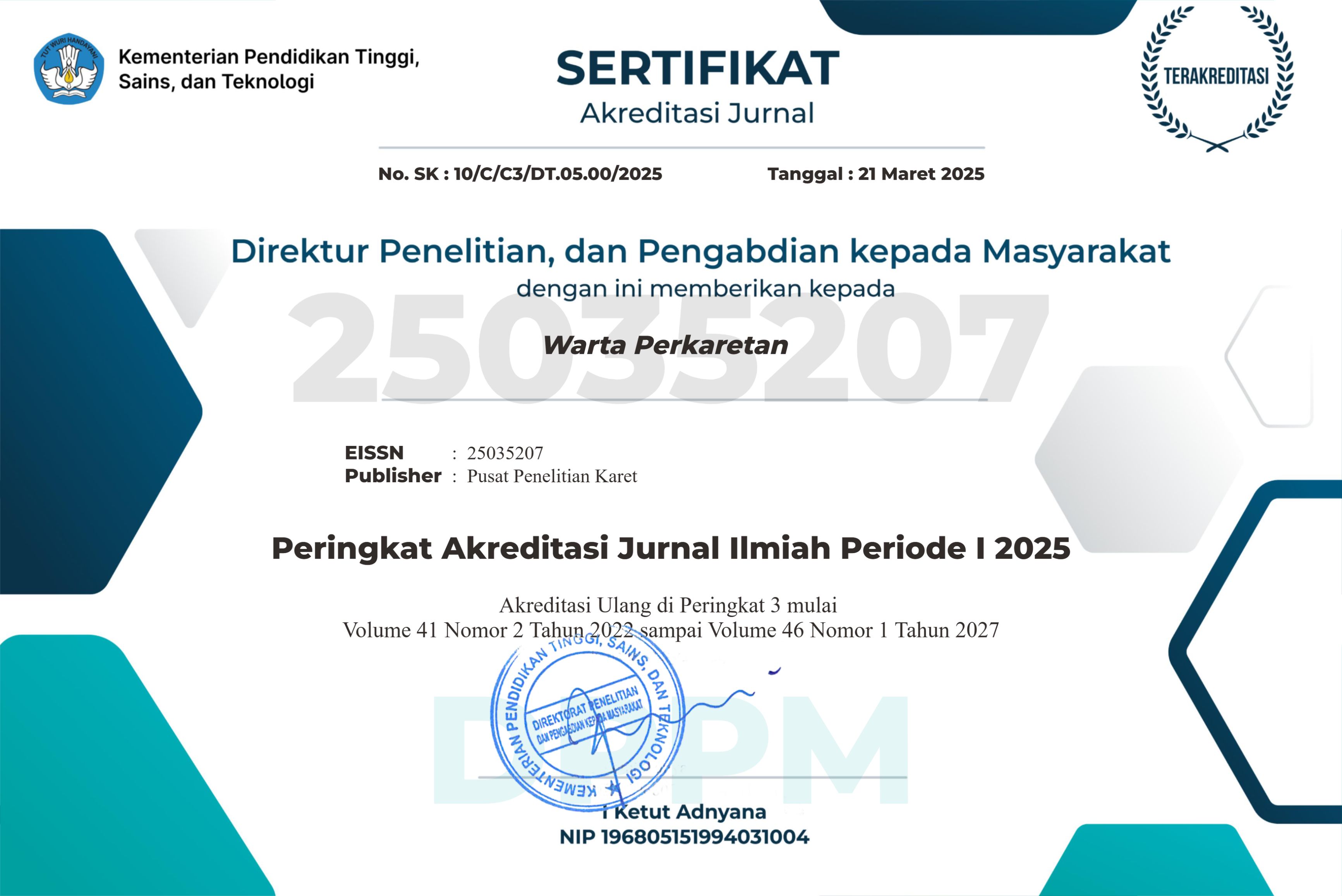OPTIMALISASI PRODUKSI DAN PENEKANAN BIAYA PENYADAPAN DENGAN SISTEM SADAP INTENSITAS RENDAH
DOI:
https://doi.org/10.22302/ppk.wp.v36i1.99Keywords:
Agronomi, Eksploitasi, Sosial ekonomiAbstract
Abstrak
Â
Pengusahaan perkebunan karet dewasa ini masih mengalami tekanan berat dan berkepanjangan, terutama akibat harganya yang rendah (±1 USD/kg). Solusi utama yang diharapkan yakni melalui aspek pasca panen (hilirisasi), namun dari aspek prapanen juga dituntut untuk memberikan solusi segera. Oleh karena itu perlu adanya suatu kajian yang komprehensif dan obyektif melalui analisis teknis dan ekonomis. Pemecahan masalah melalui pendekatan dua arah sekaligus (optimalisasi produksi dan penekanan biaya sadap), ternyata tidak mudah dilakukan. Kemungkinan rasional yang ditempuh adalah melalui orientasi produksi tinggi dengan komponen biaya normal, atau melalui pencapaian produksi normal dengan biaya rendah. Kajian berorientasi produksi tinggi dilakukan melalui penerapan penyadapan klon-klon QS (untuk wilayah Utara katulistiwa) dengan sistem sadap QS rekom, QS d4 dan Q-tap. Kajian berorientasi biaya rendah dilakukan melalui penerapan penyadapan klon-klon SS (untuk wilayah Selatan katulistiwa) dengan sistem sadap SS rekom, SS d4, SS ab (ancak besar) dan SS d6. Dari hasil pembandingan finansial, diperoleh informasi bahwa potensi keuntungan ketika harga Rp 13.600,- (85% FOB) pada tingkat biaya penyadapan langsung diperoleh pada semua sistem sadap. Potensi keuntungan pada biaya produksi tingkat kebun diperoleh pada semua sistem sadap, kecuali SS d6. Pada tingkat bahan baku (100% FOB), keuntungan tertinggi hingga terendah secara berurutan diperoleh pada sistem sadap Q-tap, QS rekom dan QS d4 (Rp 8.938.065–Rp 405.677), sedangkan pada klon SS mengalami kerugian. Dengan demikian, pengusahaan perkebunan karet (terutama saat kondisi harga rendah) pada wilayah dengan potensi klon QS sesuai menggunakan sistem sadap Q-tap, sebaliknya pada wilayah dengan potensi klon SS masih memungkinkan menggunakan SS d4. Sistem sadap SS ab meskipun memberi nilai yang lebih tinggi, kurang disarankan karena kurang sustainable. Agar pengusahaan tanaman karet menjadi lebih baik dan sustainable, perlu dikawal dengan penerapan LD secara langsung.
Â
Kata kunci : Â Karet (Hevea brasiliensis), produksi optimal, penekanan biaya penyadapan, penyadapan intensitas rendah
Â
Abstract
Â
Bussiness of rubber plantation now is still has high pressure and continuing, mainly due to the low price (±1 USD/kg). The main solution that was expected was through the post-harvest aspects, but from the pre-harvest aspects are also required to provide solutions immidiately. Therefore needed a comprehensive and objective study through technical and economical analysis. Solving the problem through approach two directions at once (optimizing the yield and suppression of tapping cost), it was not easy to do. Rational possibility that taken is through high production with normal cost component or through achievement of normal production with low cost. High production-oriented study carried out through application of QS clones tapping (for the north of the equator area) with the tapping system are QS recom, QS d4 and Q-tap. Low cost oriented study carried out through application of SS clones tapping (for the southern of the equator area) with the tapping system are SS recom, SS d4, SS lt (large task) dan SS d6. Financial comparating result obtained the information that potential profits when the price is IDR 13.600,- (85% FOB) at level of direct costs of tapping obtained in all tapping systems. Potential profits at level of ex-factory cost obtained in all tapping systems, except SS d6. At the level of TSR material (100% FOB), the profits from the highest to the lowest respectively obtained in Q-tap, QS recom and QS d4 tapping system (IDR 9 million – IDR 400 tousand), while the SS clones having losses. Thus, cultivation of rubber plantations (especially when the conditions of low prices) in regions with the potential of QS clones appropriate to use Q-tap, otherwise in regions with the potensial of SS clones still allows using SS d4. Tapping system of SS lt although giving a higher value, less recommended due to lack sustainable. Bussiness of rubber plantation in order to much better and sustainable, in future need to manage with the application of LD directly.
Â
Keywords: Rubber (Hevea brassiliensis), optimal production, suppression of cost, low tapping intensity








